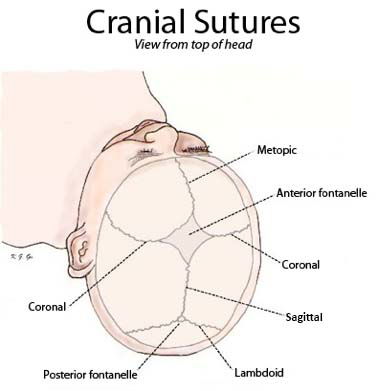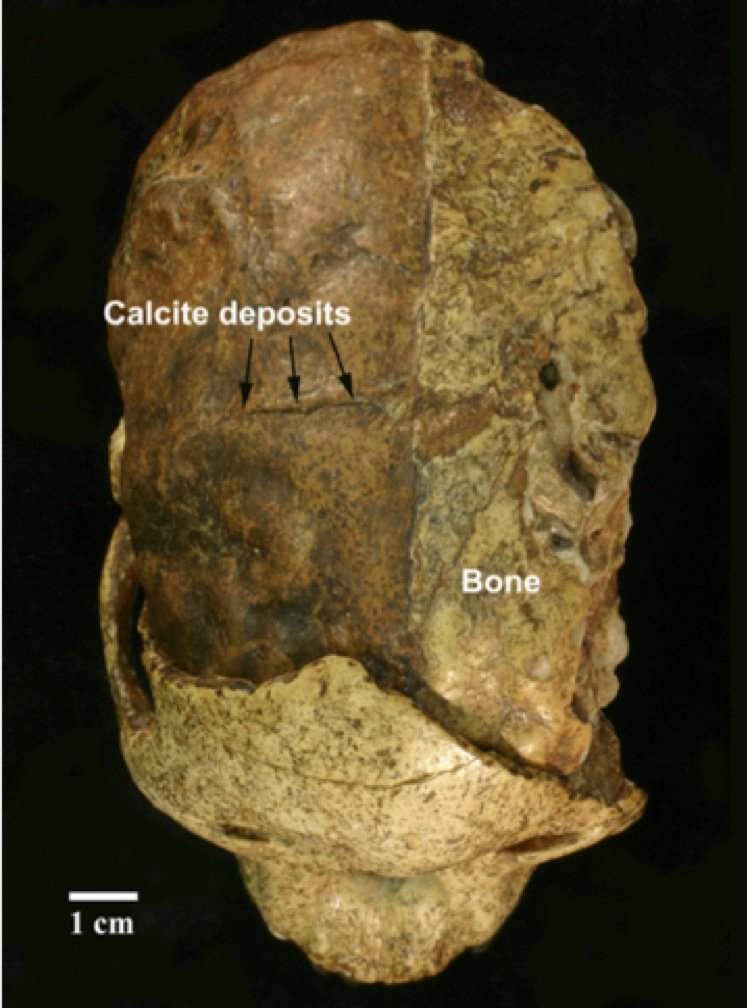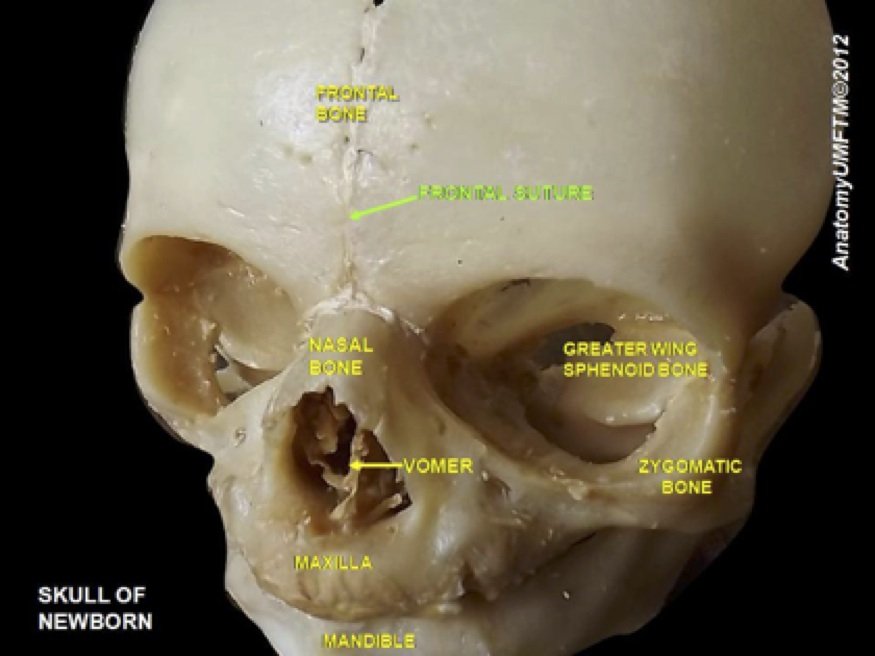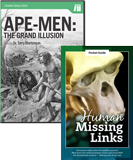
Tale of the Taung Child Collapses
News to Know
Abstract
“Evolving room for the brain to grow” was a good story, but even for evolutionists it doesn’t hold water anymore.
News Source
“Taung Child”—the first australopithecine ape discovered—didn’t blaze the trail to bigger better brains for humanity’s supposed ancestors after all. A 2012 CT X-ray analysis reported that Taung Child had an unfused frontal bone as human babies do—and quite unlike great apes. (See diagrams below.) Dean Falk and colleagues claimed that Taung Child and other hominins of its time were evolving increased capacity for expansion of the frontal brain by delaying fusion of this cranial bone. A new imaging study, published 9 September 2014 in Proceedings of the National Academy of Sciences, begs to differ.

The frontal bone of the skull is the bone beneath your forehead. Shown here in yellow on this human skull, the frontal bone covers the frontal lobe of the brain beneath. Image: LadyofHats Mariana Ruiz Villarreal via Wikimedia Commons

The frontal bone in most adults is fused into a single bone, as seen in this model of a human skull. The frontal bone normally fuses during infancy in humans. In apes, however, the frontal bone fuses before birth. (Bordering the back of the frontal bone is the coronal suture. A suture is a joint between the skull bones, and in adults the sutures are immoveable. The sagittal suture is also visible in this photograph.) Image: Ashley Hufford

The metopic suture (aka the frontal suture) divides the frontal bones in humans at birth. It normally fuses during infancy. The anterior fontanelle is the larger “soft spot” on an infant’s head, and it also fuses during childhood. Moveable sutures and fontanelles allow a baby’s head to mold during birth and allow the infant skull to expand easily to accommodate the baby’s brain. Premature fusion of a suture can cause a child to have a somewhat misshapen head. Image: Modified from “Sutures from top” by Xxjamesxx; Licensed under Creative Commons Attribution-Share Alike 3.0 via Wikimedia Commons
Of course the evolutionary story is far more flexible than the fossils from which it seeks support. Therefore, though Taung Child has lost its recently acquired prominent status in the human evolutionary hall of brains, thanks to its dissimilarity to humans it will doubtless be retained for the evolutionary variability it supposedly demonstrates.
Taung History
Taung Child was discovered in South Africa in 1924 and named Australopithecus africanus by University of Witwatersrand paleoanthropologist Raymond Dart. The fossil consists of a partial face, a lower jaw, and a partial endocast of the brain. Largely based on the immaturity of the teeth, Dart knew the skull belonged to a juvenile. He estimated its age at 6 years, an estimate that has been revised downward to 3–4 years of age.
Dart put the fossil forth as a candidate for a bipedal human ancestor based largely on the position of its foramen magnum and its small teeth. However, thanks to its small cranial capacity1 a couple of decades passed before it was accepted by the evolutionary community and immortalized in textbooks. Juveniles often differ from adults, and some thought africanus was only a chimp-like ape, but some other fossils thought to represent africanus have been found elsewhere in South Africa.
Evolutionists have varied greatly in their views of africanus, some seeing it as a noble descendant of Australopithecus afarensis, some identifying it with Australopithecus sediba, and others considering it an ordinary ape.
Taung’s Trail-Blazing Tale
In any case, Falk’s 2012 study of Taung Child gave africanus a new claim to fame by boldly asserting that its juvenile retention of an unfused frontal bone was an evolutionary advance toward human-ness. The frontal suture in modern great apes fuses by the time of birth2 but remains open in human children for 3 to 9 months during which a human infant’s brain grows rapidly.3
Falk and colleagues described an unfused suture and open anterior fontanelle (one of the so-called “soft spots” on a baby’s head). They said the suture was in the process of beginning to fuse in the zipper-like way fusion occurs in humans, from front to back. Falk proposed that prolonged mobility of the skull bones in australopithecines facilitated the birth of infants that would, in the coming million or so years, be growing bigger heads. They also indicated that the frontal brain was already reorganizing and expanding. (You can read more about this so-called “obstetrical dilemma” this presumably solved in “Tie of Human Pregnancy to Bipedality Becomes Extinct.”)
Taung’s Ignominy
Columbia University’s Ralph Holloway, Florida Atlantic University’s Douglas Broadfield, and University of Witwatersrand’s Kristian Carlson, reporting in Proceedings of the National Academy of Sciences, take issue with all of Falk’s observations and conclusions. “A recent study has described the roughly 3 million-year-old fossil, thought to have belonged to a 3- to 4-year-old, as having a persistent metopic suture and open anterior fontanelle, two features that facilitate post-natal brain growth in human infants when their disappearance is delayed,” Carlson says. However, high-resolution CT scan of the same fossil failed to find the unfused bony suture or evidence that Taung Child was evolving a more human-like brain. The one region that might arguably have been unfused was not even in the right place to support any sort of human-like pattern of front-to-back fusion.4
Even if the Taung Child had possessed an open frontal suture, the authors write, that still wouldn’t have been sufficient to demonstrate that Au. africanus was evolving frontal brain improvements in the human direction. They also failed to find evidence that the convolutions of Taung Child’s brain differed from the patterns in apes.
Furthermore, the evolving pattern of zipper-like frontal suture fusion Falk described in other early hominins, in addition to Taung Child, the authors conclude, is unsubstantiated:
In sum, we believe the claim of high frequencies of metopic [frontal] sutures in early hominins is premature, and thus the proposition that delayed metopic suture closure may have conferred a selective advantage in early hominin evolution is equally premature. Rigorous analysis of a lynchpin specimen in this argument (i.e., the Taung Child) provides no support for the notion that australopiths may have delayed metopic suture fusion, possibly for adaptive reasons.4

This is the partial cranium and endocast of Taung Child, Australopithecus africanus. In the photograph the skull’s face is downward and the jutting jaw typical of apes is easily seen. The portion of the frontal bone that is preserved is seen above this, and the endocast of the brain above that. The bregma (the intersection of the sutures bordering the parietal and frontal bones, where Falk believed there was evidence of an open anterior fontanelle) would be about 3 cm posterior to the broken margin of frontal bone in the photo. To the left of this location are calcite deposits in the coronal suture (the fused joint connecting the frontal bone to the parietal bones). Image: R. Holloway, D. Broadfield, and K. Carlson, “New high-resolution computed tomography data of the Taung partial cranium and endocast and their bearing on metopism and hominin brain evolution,” Proceedings of the National Academy of Sciences 111, no. 36 (2014):13022–13027, www.pnas.org

In these reconstructions of the Taung Child produced using high resolution CT X-ray, the midfrontal (mf) and posterior frontal (pf) regions are highlighted. If any of the frontal suture remained unfused in the Taung Child, it would be the part just above the nose, marked with arrows. (Carlson and colleagues do not believe this region was actually unfused but recognize it as a possibility.) Since fusion takes place from front-to-back, if this region were actually unfused, then it does not reflect a delay of fusion mirroring the pattern seen in humans. Image: R. Holloway, D. Broadfield, and K. Carlson, “New high-resolution computed tomography data of the Taung partial cranium and endocast and their bearing on metopism and hominin brain evolution,” Proceedings of the National Academy of Sciences 111, no. 36 (2014):13022–13027, www.pnas.org

For purposes of comparison, this is a human newborn’s skull with the unfused frontal suture labeled. This suture (a kind of joint) between the two halves of the frontal bone normally fuses between about three and nine months after birth. In some people it never fuses. Image:"Slide8nnnn" by Anatomist90 - Own work. Licensed under Creative Commons Attribution-Share Alike 3.0 via Wikimedia Commons
In trying to explain why Falk’s findings differed so radically from their own, the authors note that the Taung Child fossil is difficult to interpret due to calcite deposits and bits of fossilized bone clinging to the brain endocast.4 Furthermore, Taung Child was somewhat damaged during excavation:
Dart’s exuberant use of his wife’s knitting needles to extricate the fossil from the surrounding breccia may have scarred the surfaces, forever obliterating some of the original features of the natural endocast.4
But the chief reason the authors believe Falk and colleagues derived a completely different set of observational data from the same fossil is the difference in the quality of the CT scanners used:
Relatively low-resolution images (e.g., medical CT) likely do not offer enough spatial resolution to provide definitive evidence, as was the case with the Taung Child. Also, location discrepancies [regarding the actual location of any possibly unfused regions] observed in Taung, and seemingly in other endocasts such as KNM-ER 1813, KNM-ER 3733, and KNM-ER 3883, must be reconciled with the zipper suture closure pattern suggested by Falk and colleagues (i.e., a closure process concluding with fusion at bregma, rather than nasion/glabella). Not all purported instances of partially fused or open metopic sutures in hominin fossils support this closure model, but some may instead reflect the underlying mechanisms manifested in epigenetic or nonmetric traits.4
Carlson says that anthropologists were “trying to extend modern human-like cranial features—which allow for post-natal brain growth and which modern humans exhibit—to the Australopithecines,” but explains that “in the Taung Child, you don’t see evidence for these features.”5
Taung Redeemed
Evolutionary scientists—having lost a simplistic but visually appealing part of their human evolutionary story—must now delete Taung Child’s big claim to fame and demote it back to its primitive, merely mosaic role in the saga. Even without a roomier skull, the Smithsonian Institute suggests that Australopithecus africanus, despite its ape-like long arms, sloping face, and jutting jaw, was making progress toward human-ness because it had a rounder cranium and smaller teeth than its presumed predecessor, Australopithecus afarensis.6 Carlson says, “This doesn’t change anything about Australopithecus’s importance in human evolutionary history. But some of these unique human adaptations [such as brain size and development] should be thought of as more recent.”5
Taung in Perspective
Whether or not the frontal bone of this ape was fused or not is actually of no consequence whatever. Since Taung Child never really was a missing link, no matter what evolutionists claim, its gain or loss of supposed currency to make its case changes nothing about the reality that it is simply an extinct adolescent ape. Even if Taung Child had possessed a roomier expandable frontal region in its cranium, it would have still been an ape with no ability to acquire the genetic information to evolve into a human or any new more complex kind of animal.
Furthermore, failure of the frontal bone to fuse is of absolutely no consequence in humans. Its incidence varies in different populations. Neither fusion nor lack of fusion should be regarded as a primitive or ancestral trait. Moreover, the presence or absence of an unfused frontal suture is completely unrelated to the size, form, and functionality of underlying brain in humans. Even premature fusion is itself of no consequence to brain function, though it is associated with a number of syndromes and gives a child a somewhat keel-shaped forehead.
Nothing about this study makes the human evolutionary saga either more or less believable. God created humans (Adam and Eve, specifically) the same day He created all kinds of animals, including apes, about 6,000 years ago. Since then all animals—and people—have reproduced and varied only within created kinds, just as we infer from Genesis chapter one God designed them to do and just as observable biology demonstrates. Watching Taung Child topple has been an interesting exercise, primarily as it demonstrates the resilience of evolutionary ideas to evolve themselves to adapt to any alterations in the evidence on which they are supposedly built with an ever-changing, ever-changeable story.
Further Reading
- Lucy, the Knuckle-Walking “Abomination”?
- The Taung Skull: ‘Missing Link’?
- Did Humans Really Evolve from Apelike Creatures?
- The Origin of Humans
For More Information: Get Answers
Remember, if you see a news story that might merit some attention, let us know about it! (Note: if the story originates from the Associated Press, FOX News, MSNBC, the New York Times, or another major national media outlet, we will most likely have already heard about it.) And thanks to all of our readers who have submitted great news tips to us. If you didn’t catch all the latest News to Know, why not take a look to see what you’ve missed?
(Please note that links will take you directly to the source. Answers in Genesis is not responsible for content on the websites to which we refer. For more information, please see our Privacy Policy.)
Footnotes
- At the time of the discovery, the evolutionary community was arguing about which came first, big brains or bipedality. Dart estimated its brain capacity at 520 cc. Current estimates are even smaller—382 cc and 402-407 cc. (Capacities recounted in D. Falk, C. Zollikofer, N. Morimoto, and M. Ponce de León MS, “Metopic suture of Taung (Australopithecus africanus) and its implications for hominin brain evolution,” Proceedings of the National Academy of Sciences 109, no. 22 (2012):8467–8470, doi:10.1073/pnsd.1119752109.)
- Though sources differ slightly, Holloway et al. cite multiple sources including modern medical literature and state, “In modern humans, the metopic suture normally closes 3–9 mo postpartum, whereas in Pan, all of the sutures (including the metopic suture) normally close before birth, notably earlier than in Homo.” From page 13025 of R. Holloway, D. Broadfield, and K. Carlson, “New high-resolution computed tomography data of the Taung partial cranium and endocast and their bearing on metopism and hominin brain evolution,” Proceedings of the National Academy of Sciences 111, no. 36 (2014):13025, http://www.pnas.org/cgi/doi/10.1073/pnas.1402905111.
- Failure of the frontal bone to fuse is of absolutely no consequence in humans. Its incidence varies in different populations. Most importantly, the presence or absence of an unfused frontal suture is completely unrelated to the size, form, and functionality of underlying brain in humans. Even premature fusion is of no great consequence to brain function, though it is associated with a number of syndromes and gives a child a somewhat keel-shaped forehead.
- R. Holloway, D. Broadfield, and K. Carlson, “New high-resolution computed tomography data of the Taung partial cranium and endocast and their bearing on metopism and hominin brain evolution,” Proceedings of the National Academy of Sciences 111, no. 36 (2014):13022–13027, http://www.pnas.org/cgi/doi/10.1073/pnas.1402905111.
- http://mg.co.za/article/2014-08-27-taung-child-was-not-as-advanced-for-his-age-as-thought
- http://humanorigins.si.edu/evidence/human-fossils/species/australopithecus-africanus
Recommended Resources

Answers in Genesis is an apologetics ministry, dedicated to helping Christians defend their faith and proclaim the good news of Jesus Christ.
- Customer Service 800.778.3390
- © 2024 Answers in Genesis



